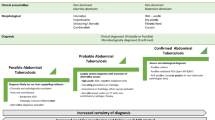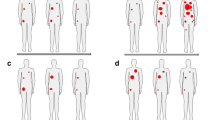Abstract
Background
Initial studies of tuberculosis (TB) in macaques and humans using 18F-FDG positron emission tomography (PET) imaging as a research tool suggest its usefulness in localising disease sites and as a clinical biomarker. Sequential serial scans in patients with extrapulmonary TB (EPTB) could inform on the value of PET-CT for monitoring response to treatment and defining cure.
Patients and methods
HIV-negative adults with EPTB from eight sites across six countries had three 18F-FDG PET/CT scans: (i) within 2 weeks of enrolment, (ii) at 2 months into TB treatment and (iii) at end of ATT treatment. Scanning was performed according to the EANM guidelines. 18F-FDG PET/CT scans were performed 60 ± 10 min after intravenous injection of 2.5–5.0 MBq/kg of 18F-FDG.
Findings
One hundred and forty-seven patients with EPTB underwent 3 sequential scans. A progressive reduction over time of both the number of active sites and the uptake level (SUVmax) at these sites was seen. At the end of WHO recommended treatment, 53/147 (36.0%) patients had negative PET/CT scans, and 94/147 (63.9%) patients remained PET/CT positive, of which 12 patients had developed MDR TB. One died of brain tuberculoma.
Interpretation
Current 18F-FDG PET/CT imaging technology cannot be used clinically as a biomarker of treatment response, cure or for decision-making on when to stop EPTB treatment. PET/CT remains a research tool for TB and further development of PET/CT is required using new Mycobacterium tuberculosis-specific radiopharmaceuticals targeting high-density surface epitopes, gene targets or metabolic pathways.







Similar content being viewed by others
References
WHO. Global Tuberculosis Report 2019. 2019. https://www.who.int/tb/publications/global_report/en/. Accessed 10th December 2019.
Sharma SK, Mohan A. Extrapulmonary tuberculosis. Indian J Med Res. 2004;120:316–53.
Sreeramareddy CT, Panduru KV, Verma SC, Joshi HS, Bates MN. Comparison of pulmonary and extrapulmonary tuberculosis in Nepal-a hospital-based retrospective study. BMC Infect Dis. 2008;8:8.
Ilgazli A, Boyaci H, Basyigit I, Yildiz F. Extra pulmonary tuberculosis: clinical and epidemiologic spectrum of 636 cases. Arch Med Res. 2004;35:435–341.
Solovic I, Jonsson J, Korzeniewska-Koseła M, et al. Challenges in diagnosing extrapulmonary tuberculosis in the European Union, 2011. Euro Surveill. 2013;18(12).
Kulchavenya E. Extrapulmonary tuberculosis: are statistical reports accurate? Ther Adv Infect Dis. 2014;2:61–70.
World Health Organization. Improving the diagnosis and treatment of smear-negative pulmonary and extrapulmonary tuberculosis among adults and adolescents. 2006. https://www.who.int/tb/publications/2006/tbhiv_recommendations.pdf. Accessed 4 October 2018.
Zhuang H, Alavi A. 18-Fluorodeoxyglucose positron emission tomographic imaging in the detection and monitoring of infection and inflammation. Semin Nucl Med. 2002;32:47–59.
Boellaard R, Delgado-Bolton R, Oyen WJ, et al. FDG PET/CT: EANM procedure guidelines for tumour imaging: version 2.0. Eur J Nucl Med Mol Imaging. 2015;42:328–54.
Coleman MT, Maiello P, Tomko J, et al. Early changes by (18)fluorodeoxyglucose positron emission tomography co-registered with computed tomography predict outcome after Mycobacterium tuberculosis infection in cynomolgus macaques. Infect Immun. 2014;82:2400–4.
Lin PL, Coleman T, Carney JP, et al. Radiologic responses in cynomolgous macaques for assessing tuberculosis chemotherapy regimens. Antimicrob Agents Chemother. 2013;57:4237–44.
Coleman M, Chen R, Lee M, et al. PET/CT imaging reveals a therapeutic response to oxazolidinones in macaques and humans with tuberculosis. Sci Transl Med. 2014;6(265):265ra167. https://doi.org/10.1126/scitranslmed.3009500.
Via LE, Schimel D, Weiner DM, et al. Infection dynamics and response to chemotherapy in a rabbit model of tuberculosis using [18F]2-fluoro-deoxy-D-glucose positron emission tomography and computed tomography. Antimicrob Agents Chemother. 2012;56:4391–402.
Martinez V, Castilla-Lievre MA, Guillet-Caruba C, et al. (18)F-FDG PET/CT in tuberculosis: an early non-invasive marker of therapeutic response. Int J Tuberc Lung Dis. 2012;16:1180–5.
Martin C, Castaigne C, Vierasu I, Garcia C, Wyndham-Thomas C, de Wit S. Prospective serial FDG PET/CT during treatment of extrapulmonary tuberculosis in HIV-infected patients: an exploratory study. Clin Nucl Med. 2018;43:635–40.
Dureja S, Sen I, Acharya S. Potential role of F18 FDG PET/CT as an imaging biomarker for the non-invasive evaluation in uncomplicated skeletal tuberculosis: a prospective clinical observational. Eur Spine J. 2014;23:2449–54.
Stelzmueller I, Huber H, Wunn R, et al. 18F-FDG PET/CT in the initial assessment and for follow-up in patients with tuberculosis. Clin Nucl Med. 2016;41:e187–94.
Jain A, Goyal MK, Mittal BR, et al. 18FDG-PET is sensitive tool for detection of extracranial tuberculous foci in central nervous system tuberculosis—preliminary observations from a tertiary care center in northern India [published online ahead of print, 2019 Nov 27]. J Neurol Sci. 2019;409:116585. https://doi.org/10.1016/j.jns.2019.116585.
Jeon I, Kong E, Kim SW. Simultaneous 18F-FDG PET/MRI in tuberculous spondylitis: an independent method for assessing therapeutic response—case series. BMC Infect Dis. 2019;19(1):845. https://doi.org/10.1186/s12879-019-4469-2.
Bomanji J, Sharma R, Mittal BR, et al. PET/CT features of extrapulmonary tuberculosis at first clinical presentation: a cross-sectional observational 18F-FDG imaging study across six countries. Eur Respir J. 2020;55(2). https://doi.org/10.1183/13993003.01959-2019.
Gilpin C, Korobitsyn A, Migliori GB, Raviglione MC, Weyer K. The World Health Organization standards for tuberculosis care and management. Eur Respir J. 2018;51.
Heysell SK, Thomas TA, Sifri CD, Rehm PK, Houpt ER. 18-Fluorodeoxyglucose positron emission tomography for tuberculosis diagnosis and management: a case series. BMC Pulm Med. 2013;13:14.
Ganchua SKC, Cadena AM, Maiello P, et al. Lymph nodes are sites of prolonged bacterial persistence during Mycobacterium tuberculosis infection in macaques. PLoS Pathog. 2018;14:e1007337.
Jain AK, Sreenivasan R, Saini NS, Kumar S, Jain S, Dhammi IK. Magnetic resonance evaluation of tubercular lesion in spine. Int Orthop. 2012;36:261–9.
Lin PL, Ford CB, Coleman MT, et al. Sterilization of granulomas is common in both active and latent tuberculosis despite extensive within-host variability in bacterial killing. Nat Med. 2014;20:75–9.
Malherbe ST, Shenai S, Ronacher K, et al. Persisting positron emission tomography lesion activity and Mycobacterium tuberculosis mRNA after tuberculosis cure. Nat Med. 2016;22:1094–100.
Sathekge M, Maes A, Kgomo M, Stoltz A, Van de Wiele C. Use of 18F-FDG PET to predict response to first-line tuberculostatic in HIV-associated tuberculosis. J Nucl Med. 2011;52:880–5.
Chen RY, Via LE, Dodd LE, et al. Using biomarkers to predict TB treatment duration (predict TB): a prospective, randomized, noninferiority, treatment shortening clinical trial. Gates Open Res. 2017;1:9.
Tucker EW, Guglieri-Lopez B, Ordonez AA, et al. Non-invasive 11C-rifampin positron emission tomography reveals drug biodistribution in tuberculous meningitis. Sci Transl Med. 2018;10.
Niyonkuru A, Bakari KH, Lan X. 18F-fluoro-2-deoxy-d-glucose pet/computed tomography evaluation of lung cancer in populations with high prevalence of tuberculosis and other granulomatous disease. PET Clin. 2018;13:19–31.
Acknowledgements
Prof Sir Zumla and Prof Bomanji acknowledge support from the NIHR Biomedical Centre at UCL Hospitals Foundation NHS Trust. Sir Zumla holds an NIHR senior Investigator award and he is co-Principal Investigator of the Pan-African Network on Emerging and Re-Emerging Infections (PANDORA-ID-NET—https://www.pandora-id.net/) funded by the European and Developing Countries Clinical Trials Partnership the EU Horizon 2020 Framework Programme for Research and Innovation.
Role of funding source and oversight
The International Atomic Energy Agency (IAEA) aided in selection of recruitment centres with appropriate 18F-FDG PET/CT imaging facilities and funding for 18F-FDG PET/CT scans, consortium meetings and central facilities for data storage. None of the investigators received any payments.
Author information
Authors and Affiliations
Contributions
Jamshed Bomanji, Thomas NB Pascual and Alimuddin Zumla developed the concept and initiated discussions which led to the formation of the consortium. Rajnish Sharma, Bhagwant Rai Mittal, Sanjay Gambhir, Ahmad Qureshy, Shamim Momtaz Ferdousi Begum, Mike Sathekge, Mariza Vorster, Dragana Sobic Saranovic and Pawana Pusuwan led the study sites. Sobhan Vinjamuri conducted quality assessment of imaging data. Olga Morozova collated the CRFs. Vera Mann performed the data analyses. Jamshed Bomanji led the imaging studies and, with Alimuddin Zumla, Diana Paez and Thomas NB Pascual, developed the first and final drafts of the manuscript. All authors contributed to data interpretation and writing of the manuscript.
Corresponding author
Ethics declarations
Conflict of interest
The authors declare that they have no conflict of interest.
Ethical approval
IAEA, Committee for Coordinated Research Activities, Nuclear Sciences and Applications (05-02-14). All procedures performed in participants were in accordance with ethical standards of the local institution and/or national research committee and in line with the 1964 Helsinki declaration and its later amendments.
Informed consent
Informed consent was obtained from all individual participants included in the study.
Additional information
Publisher’s note
Springer Nature remains neutral with regard to jurisdictional claims in published maps and institutional affiliations.
This article is part of the Topical Collection on Infection and inflammation.
Electronic supplementary material
ESM 1
(DOC 156 kb)
Rights and permissions
About this article
Cite this article
Bomanji, J., Sharma, R., Mittal, B.R. et al. Sequential 18F-fluorodeoxyglucose positron emission tomography (18F-FDG PET) scan findings in patients with extrapulmonary tuberculosis during the course of treatment—a prospective observational study. Eur J Nucl Med Mol Imaging 47, 3118–3129 (2020). https://doi.org/10.1007/s00259-020-04888-7
Received:
Accepted:
Published:
Issue Date:
DOI: https://doi.org/10.1007/s00259-020-04888-7




